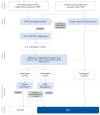Challenges in the Definitive Diagnosis of Niemann-Pick Type C-Leaky Variants and Alternative Transcripts
- PMID: 38002933
- PMCID: PMC10671040
- DOI: 10.3390/genes14111990
Challenges in the Definitive Diagnosis of Niemann-Pick Type C-Leaky Variants and Alternative Transcripts
Abstract
Niemann-Pick type C (NPC, ORPHA: 646) is a neuro-visceral, psychiatric disease caused predominantly by pathogenic variants in the NPC1 gene or seldom in NPC2. The rarity of the disease, and its wide range of clinical phenotypes and ages of onset, turn the diagnosis into a significant challenge. Other than the detailed clinical history, the typical diagnostic work-up for NPC includes the quantification of pathognomonic metabolites. However, the molecular basis diagnosis is still of utmost importance to fully characterize the disorder. Here, the authors provide an overview of splicing variants in the NPC1 and NPC2 genes and propose a new workflow for NPC diagnosis. Splicing variants cover a significant part of the disease-causing variants in NPC. The authors used cDNA analysis to study the impact of such variants, including the collection of data to classify them as leaky or non-leaky pathogenic variants. However, the presence of naturally occurring spliced transcripts can misdiagnose or mask a pathogenic variant and make the analysis even more difficult. Analysis of the NPC1 cDNA in NPC patients in parallel with controls is vital to assess and detect alternatively spliced forms. Moreover, nonsense-mediated mRNA decay (NMD) analysis plays an essential role in evaluating the naturally occurring transcripts during cDNA analysis and distinguishing them from other pathogenic variants' associated transcripts.
Keywords: NPC1 gene; Niemann–Pick type C; leaky variants; molecular diagnosis; splicing variants.
Conflict of interest statement
The authors declare no conflict of interest.
Figures



References
-
- Millat G., Baïlo N., Molinero S., Rodriguez C., Chikh K., Vanier M.T. Niemann-Pick C Disease: Use of Denaturing High Performance Liquid Chromatography for the Detection of NPC1 and NPC2 Genetic Variations and Impact on Management of Patients and Families. Mol. Genet. Metab. 2005;86:220–232. doi: 10.1016/j.ymgme.2005.07.007. - DOI - PubMed
-
- Wassif C.A., Cross J.L., Iben J., Sanchez-Pulido L., Cougnoux A., Platt F.M., Ory D.S., Ponting C.P., Bailey-Wilson J.E., Biesecker L.G., et al. High Incidence of Unrecognized Visceral/Neurological Late-Onset Niemann-Pick Disease, Type C1, Predicted by Analysis of Massively Parallel Sequencing Data Sets. Genet. Med. 2016;18:41–48. doi: 10.1038/gim.2015.25. - DOI - PMC - PubMed
-
- Pineda M., Mengel E., Jahnová H., Héron B., Imrie J., Lourenço C.M., van der Linden V., Karimzadeh P., Valayannopoulos V., Jesina P., et al. A Suspicion Index to Aid Screening of Early-Onset Niemann-Pick Disease Type C (NP-C) BMC Pediatr. 2016;16:107. doi: 10.1186/s12887-016-0641-7. - DOI - PMC - PubMed
Publication types
MeSH terms
Substances
Grants and funding
LinkOut - more resources
Full Text Sources

